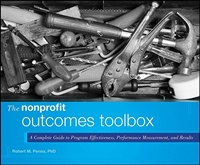 Any book that claims to be a ‘complete guide’ sets itself up for disappointment, and this problem applies to The Nonprofit Outcomes Toolbox. This is a shame because the book contains a lot of important ideas and information that many (including me) will find new and useful. But it also skips over ideas that I see as fundamental to measuring and managing outcomes, while covering tangential issues in depth. In general, the message and content of the book is sound, and it makes a valuable contribution to the promotion of measuring and managing outcomes. But it is not complete and not the final word. A reader that is new to the area of performance management and measuring effectiveness might be misled by the title and would not know what is missing.
Any book that claims to be a ‘complete guide’ sets itself up for disappointment, and this problem applies to The Nonprofit Outcomes Toolbox. This is a shame because the book contains a lot of important ideas and information that many (including me) will find new and useful. But it also skips over ideas that I see as fundamental to measuring and managing outcomes, while covering tangential issues in depth. In general, the message and content of the book is sound, and it makes a valuable contribution to the promotion of measuring and managing outcomes. But it is not complete and not the final word. A reader that is new to the area of performance management and measuring effectiveness might be misled by the title and would not know what is missing.
The structure and layout of the book is designed, as the author notes, to be read in its entirety or dipped into as needed. This format works well, as each chapter is mostly self-contained. The book also includes exercises at the end of each chapter for readers to apply the ideas to their own organization.
I can see how this can be useful, but I wonder whether anyone actually does these exercises and whether there is much point in readers doing them by themselves in any case. One of the challenges facing people who want to make their non-profits become more outcome-focused is bringing other people – other staff, board members and stakeholders – along in that journey. For this reason some of these exercises may be better done by groups, not just the reader. This, however, raises the possibility that once in a group setting the book’s (sound) ideas and approaches will get twisted by inertia and resistance. But how to apply the ideas and deal with these change management issues is one area that is given little attention.
The strongest section is the one on the ‘basics’. The book neatly covers the different approaches that non-profits can take, such as addressing problems, managing activities and processes or pursuing visions, and explains why these management approaches, while useful in their own right, are not so good at managing outcomes. In doing this, the author points out some truths that may be uncomfortable for some. A focus on vision, he says, tends to ‘rely on assumptions that are rarely examined, challenged, or tested’. The book also does a good job of getting terminology straight and setting out what makes a good outcome to measure.
But even in this best section there is one significant gap. The author refers in places to an organization’s ‘theory of change’ but does not explain what this is (how the organization expects to bring about positive change based on what it does, given the context in which it operates) nor how it relates to managing outcomes. But having a robust theory of change is the bedrock on which an outcome framework is built. This is implicitly acknowledged in the book, so it is surprising it gets so little attention.
The remaining sections mostly discuss particular tools and approaches to setting up, managing and communicating outcomes. Again, there is a lot of good material. I particularly liked the section on how to convert measures and information into stories to communicate results in a way that is naturally appealing.
But I was also struck by the gaps. To my mind the most noticeable were the absence of any discussion about: how to attribute outcomes to organizational activities (for example, the limits of ‘before’ and ‘after’ comparisons); and using existing evidence (from academic or other sources) to help establish the causal links between activities and outcomes. It also fails to go into how to create a culture of outcome measurement/performance in an organization, including dealing with all the change management sensitivities that go along with that. The section on Advanced Tools is selective in a way that is not clear to me. The author devotes a chapter to Six Sigma but underplays the obstacles in fully applying the Six Sigma methodology to the non-profit service organizations that the book is aimed at. In contrast, other quality improvement approaches that may be just as, or more, useful to non-profits get only a passing mention.
So overall this gets a mixed review. The ideas and tools it puts forward are sound, and for the novice reader it is a very good starting point. The book’s deficiencies lie in what it omits, not what it contains. And that, as noted at the beginning, is a problem with describing it as a complete guide.
David Pritchard is Head of Measurement and Evaluation at New Philanthropy Capital. Email DPritchard@philanthropycapital.org
The Nonprofit Outcomes Toolbox: A complete guide to program effectiveness, performance measurement, and results
Robert Penna Wiley £47.50/$70
ISBN 9781118004500
To order
http://www.wiley.com






Comments (0)